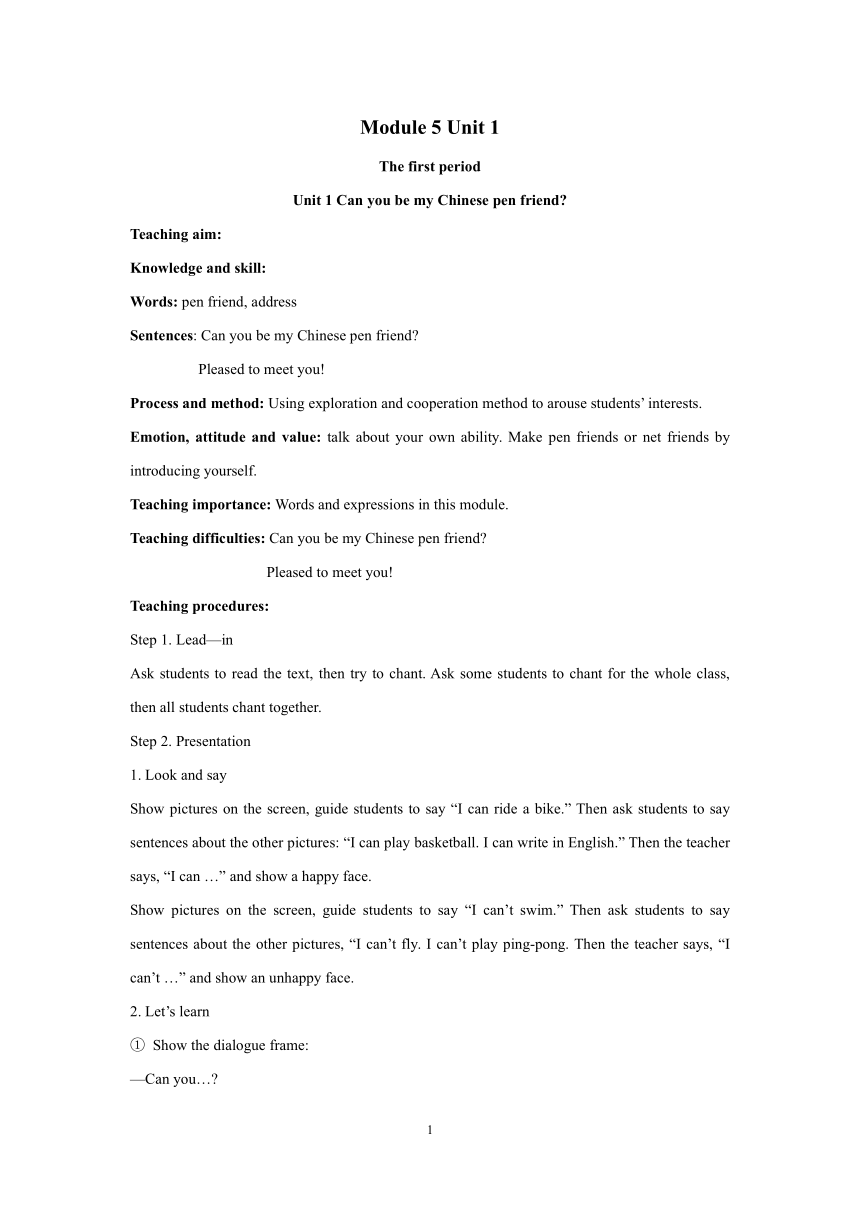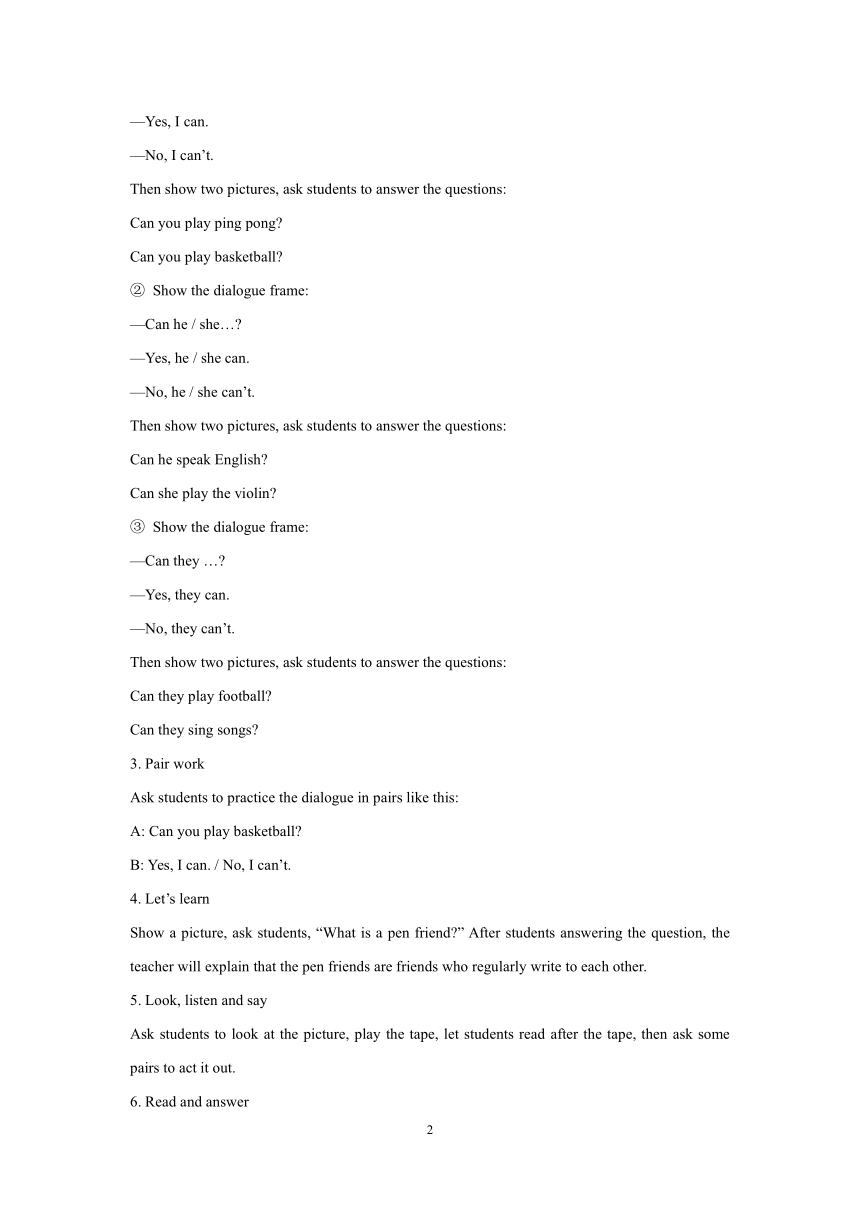Module 5 Unit 1 Can you be my Chinese pen friend? The first period 英文教案
文档属性
| 名称 | Module 5 Unit 1 Can you be my Chinese pen friend? The first period 英文教案 |  | |
| 格式 | docx | ||
| 文件大小 | 18.3KB | ||
| 资源类型 | 教案 | ||
| 版本资源 | 外研版(三年级起点) | ||
| 科目 | 英语 | ||
| 更新时间 | 2021-12-15 09:11:38 | ||
图片预览


文档简介
Module 5 Unit 1
The first period
Unit 1 Can you be my Chinese pen friend
Teaching aim:
Knowledge and skill:
Words: pen friend, address
Sentences: Can you be my Chinese pen friend
Pleased to meet you!
Process and method: Using exploration and cooperation method to arouse students’ interests.
Emotion, attitude and value: talk about your own ability. Make pen friends or net friends by introducing yourself.
Teaching importance: Words and expressions in this module.
Teaching difficulties: Can you be my Chinese pen friend
Pleased to meet you!
Teaching procedures:
Step 1. Lead—in
Ask students to read the text, then try to chant. Ask some students to chant for the whole class, then all students chant together.
Step 2. Presentation
1. Look and say
Show pictures on the screen, guide students to say “I can ride a bike.” Then ask students to say sentences about the other pictures: “I can play basketball. I can write in English.” Then the teacher says, “I can …” and show a happy face.
Show pictures on the screen, guide students to say “I can’t swim.” Then ask students to say sentences about the other pictures, “I can’t fly. I can’t play ping-pong. Then the teacher says, “I can’t …” and show an unhappy face.
2. Let’s learn
① Show the dialogue frame:
—Can you…
—Yes, I can.
—No, I can’t.
Then show two pictures, ask students to answer the questions:
Can you play ping pong
Can you play basketball
② Show the dialogue frame:
—Can he / she…
—Yes, he / she can.
—No, he / she can’t.
Then show two pictures, ask students to answer the questions:
Can he speak English
Can she play the violin
③ Show the dialogue frame:
—Can they …
—Yes, they can.
—No, they can’t.
Then show two pictures, ask students to answer the questions:
Can they play football
Can they sing songs
3. Pair work
Ask students to practice the dialogue in pairs like this:
A: Can you play basketball
B: Yes, I can. / No, I can’t.
4. Let’s learn
Show a picture, ask students, “What is a pen friend ” After students answering the question, the teacher will explain that the pen friends are friends who regularly write to each other.
5. Look, listen and say
Ask students to look at the picture, play the tape, let students read after the tape, then ask some pairs to act it out.
6. Read and answer
Ask students to read the dialogue in Part 2 quickly, then answer the questions:
①Can Daming speak English
②Where is Laura from
③Who’re Daming’s friends from the UK
④Can Laura write to Daming’s friends
⑤Can Laura write in Chinese
⑥Can Laura write to Sam and Amy
⑦Can Daming be Laura’s Chinese pen friend
Read the first part, find the sentences connected with the questions and underline the sentences, then try to answer the questions. The teacher helps to check the answers:
①Yes, he can.
②She is from the UK.
Read the second part, find the sentences connected with the questions and underline the sentences, then try to answer the questions. The teacher helps to check the answers:
③Sam and Amy.
④Yes, she can.
Read the third part, find the sentences connected with the questions and underline the sentences, then try to answer the questions. The teacher helps to check the answers:
⑤No, she can’t.
⑥Yes, he can.
⑦Yes, he can.
Step 3. Practice
1. Watch and act out
Play the cartoon【角色扮演】Can you be my Chinese pen friend?对话练习, students watch and then act it out with partners.
2. Listen and say
Play the tape, students read after the tape, then students read the dialogue in pairs.
3. Group work
Ask 4 students come to the stage and say one sentence one by one.
4. Do the exercise, then check the answers together.
Step 4. Homework
1. Write three times each word: pen friend\address\pleased to meet you;
2. Recite and write three times the sentences in Part 3, on Page 28;
3. Read the text more than three times in Module 5, Unit 1.
板书设计:
Unit 1 Can you be my Chinese pen friend
—Can you … —Yes, I can. —No, I can’t.
—Can he / she … —Yes, he / she can. —No, he / she can’t.
—Can they … —Yes, they can. —No, they can’t.
4
The first period
Unit 1 Can you be my Chinese pen friend
Teaching aim:
Knowledge and skill:
Words: pen friend, address
Sentences: Can you be my Chinese pen friend
Pleased to meet you!
Process and method: Using exploration and cooperation method to arouse students’ interests.
Emotion, attitude and value: talk about your own ability. Make pen friends or net friends by introducing yourself.
Teaching importance: Words and expressions in this module.
Teaching difficulties: Can you be my Chinese pen friend
Pleased to meet you!
Teaching procedures:
Step 1. Lead—in
Ask students to read the text, then try to chant. Ask some students to chant for the whole class, then all students chant together.
Step 2. Presentation
1. Look and say
Show pictures on the screen, guide students to say “I can ride a bike.” Then ask students to say sentences about the other pictures: “I can play basketball. I can write in English.” Then the teacher says, “I can …” and show a happy face.
Show pictures on the screen, guide students to say “I can’t swim.” Then ask students to say sentences about the other pictures, “I can’t fly. I can’t play ping-pong. Then the teacher says, “I can’t …” and show an unhappy face.
2. Let’s learn
① Show the dialogue frame:
—Can you…
—Yes, I can.
—No, I can’t.
Then show two pictures, ask students to answer the questions:
Can you play ping pong
Can you play basketball
② Show the dialogue frame:
—Can he / she…
—Yes, he / she can.
—No, he / she can’t.
Then show two pictures, ask students to answer the questions:
Can he speak English
Can she play the violin
③ Show the dialogue frame:
—Can they …
—Yes, they can.
—No, they can’t.
Then show two pictures, ask students to answer the questions:
Can they play football
Can they sing songs
3. Pair work
Ask students to practice the dialogue in pairs like this:
A: Can you play basketball
B: Yes, I can. / No, I can’t.
4. Let’s learn
Show a picture, ask students, “What is a pen friend ” After students answering the question, the teacher will explain that the pen friends are friends who regularly write to each other.
5. Look, listen and say
Ask students to look at the picture, play the tape, let students read after the tape, then ask some pairs to act it out.
6. Read and answer
Ask students to read the dialogue in Part 2 quickly, then answer the questions:
①Can Daming speak English
②Where is Laura from
③Who’re Daming’s friends from the UK
④Can Laura write to Daming’s friends
⑤Can Laura write in Chinese
⑥Can Laura write to Sam and Amy
⑦Can Daming be Laura’s Chinese pen friend
Read the first part, find the sentences connected with the questions and underline the sentences, then try to answer the questions. The teacher helps to check the answers:
①Yes, he can.
②She is from the UK.
Read the second part, find the sentences connected with the questions and underline the sentences, then try to answer the questions. The teacher helps to check the answers:
③Sam and Amy.
④Yes, she can.
Read the third part, find the sentences connected with the questions and underline the sentences, then try to answer the questions. The teacher helps to check the answers:
⑤No, she can’t.
⑥Yes, he can.
⑦Yes, he can.
Step 3. Practice
1. Watch and act out
Play the cartoon【角色扮演】Can you be my Chinese pen friend?对话练习, students watch and then act it out with partners.
2. Listen and say
Play the tape, students read after the tape, then students read the dialogue in pairs.
3. Group work
Ask 4 students come to the stage and say one sentence one by one.
4. Do the exercise, then check the answers together.
Step 4. Homework
1. Write three times each word: pen friend\address\pleased to meet you;
2. Recite and write three times the sentences in Part 3, on Page 28;
3. Read the text more than three times in Module 5, Unit 1.
板书设计:
Unit 1 Can you be my Chinese pen friend
—Can you … —Yes, I can. —No, I can’t.
—Can he / she … —Yes, he / she can. —No, he / she can’t.
—Can they … —Yes, they can. —No, they can’t.
4
同课章节目录
- Module 1
- Unit 1 It's more than twenty thousand kilometers l
- Unit 2 It's in the west.
- Module 2
- Unit 1 There's Chinese dancing.
- Unit 2 There are lots of beautiful lakes in China.
- Module 3
- Unit 1 Collecting stamps is my hobby.
- Unit 2 What's your hobby?
- Module 4
- Unit 1 Thanksgiving is my favourite festival.
- Unit 2 Our favourite festival is the Spring Festiv
- Module 5
- Unit 1 Can you be my Chinese pen friend?
- Unit 2 I can speak French.
- Module 6
- Unit 1 You've got a letter from New York.
- Unit 2 I've got a stamp from China.
- Module 7
- Unit 1 I don't believe it.
- Unit 2 Pandas love bamboo.
- Module 8
- Unit 1 Do you often play with dolls?
- Unit 2 I often go swimming.
- Module 9
- Unit 1 Do you want to visit the UN building?
- Unit 2 I want to go to Shanghai.
- Review Module
- Unit 1
- Unit 2
- Module 10
- Unit 1 Don't talk in the library.
- Unit 2 Go straight on!
